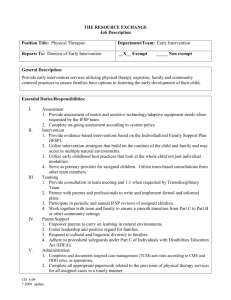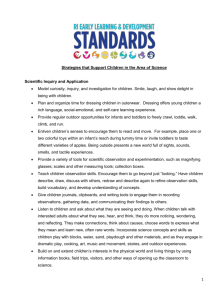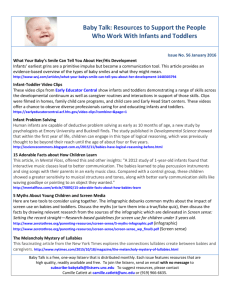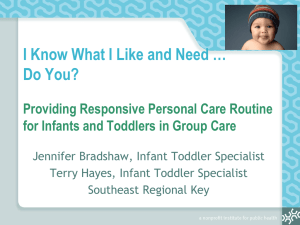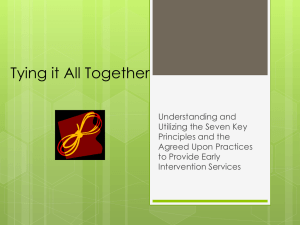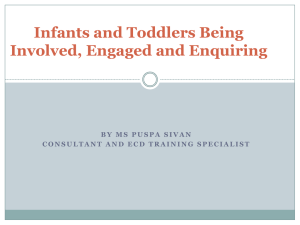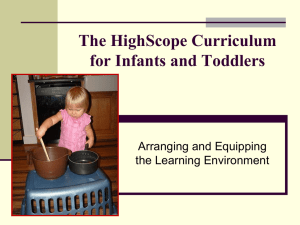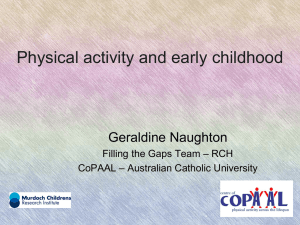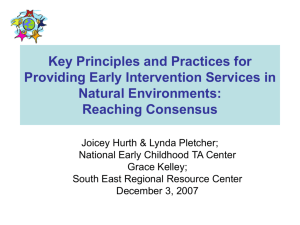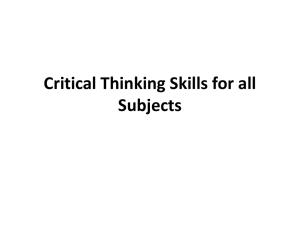(2010) (NY) - The Early Childhood Technical Assistance Center
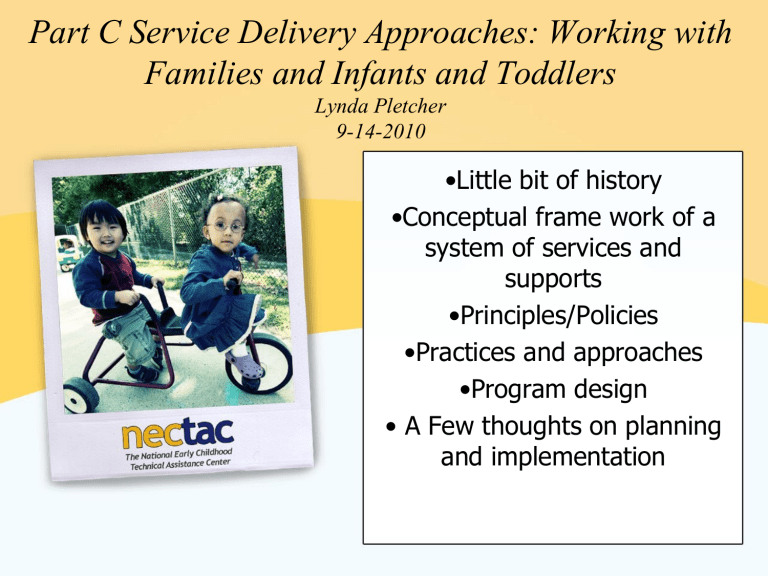
Part C Service Delivery Approaches: Working with
Families and Infants and Toddlers
Lynda Pletcher
9-14-2010
•Little bit of history
•Conceptual frame work of a system of services and supports
•Principles/Policies
•Practices and approaches
•Program design
• A Few thoughts on planning and implementation
System of Services/Part C
• “Making a Difference for Children and Families”
Changes in funding
Principles/Policy
(Why we do)
Vision, Values, Beliefs,
State and Federal Laws, Rules, Policy
Political Will
Priorities and requirements
Re-organization
Research
Practices
(What//how we do)
Eligibility, evaluation and assessment,
IFSP development, ongoing services in natural environments, ongoing assessment, transition, service coordination
Program Design
(How we’re organized)
State/regional/local infrastructure: service system models, MOA, PR, finance, data collection ,training/ TA,
Quality Assurance, monitoring,
Licensure/certification
= Desired Results for Children and Families (Outcomes)
Adapted from: Lynda Cook Pletcher. Family Enablement Project, Spring 1991 Newsletter
Desired results for Infants toddlers and their families
Our EI History
Various programs from different departments at the federal level began and continue today in some form:
• 1968- Bureau of Education for the Handicapped –provides competitive funding to 20 centers to develop models for working with children with disabilities (become OSEP and RTP)
• Emphasis War on Poverty created Head Start (1965), Early Head Start
• Early Periodic a Screening and Diagnosis and Treatment Act under
Social security (Title XIX) (1967)
• University Disability Centers (UAP) now called UCEDD’s
• Maternal Child Health established Children's Special Health Clinics
All leading up to 1986
• Passage of PL 99-457 (1986) created a section” H” (Part H) in the Education for Handicapped children Act to establish services for infants/ Toddlers (birth to 3) and their families
• Several re-authorizations continuing firm commitment to the birth to three and preschool populations
• Currently (2004) Individuals with Disabilities Education
Improvement Act (IDEA)- “Part C” remains with a few new provisions. (The Regulations we continue to use are from
1999)
Circle one: Policies and Principles
Why we do what we do
• Federal and state laws, regulations, State policy and guidance (legal authority)
• Beliefs and values the state system articulates (and individuals) about young children with disabilities and their families and the type of services and supports that are
“best”.
Purpose of the Infants and Toddlers
Program.
• Enhancing the capacity of families to meet the special needs of their infant and toddler with disabilities and
• Enhancing the capacity of states and local agencies and service providers to identify, evaluate and meet the needs of all children, particularly low income, inner city, rural and infants and toddlers in foster care.
The Law (Statute and Regulations) support
• Variation in State and local design ( eg. State choice in who is eligible to receive services)
• Dual focus of serving children and families
• Active participation of families in all aspects of service delivery
• Teaming
• Identified needs of the child and family determined which services are to be provided
• Individualized services that can change as often as families or other team members feel is needed
• Coordinating Services from a variety of agencies and programs
• Services are to be provided in home and other community settings where children without disabilities participate
• All other funding sources are used prior to drawing down the Federal
Part C funds
Values and beliefs
Some questions that our values and beliefs shape our answers to…
How do children learn and develop?
How do children with disabilities grow and develop?
What is the role of families in helping their child?
What do we think about certain types of families?
What is the best way to provide “help” to families
As a provider how do I see my role and interactions with families?
Example 1:
The Infant-Toddler Program is a variety of agencies working together to provide early intervention services for children ages birth to three who have special needs and their families. Early intervention services help young children grow and develop and support their families in caring for them.
Principles of the Infant-Toddler Program
To promote the importance of families in guiding the services of children with special needs, the Infant-Toddler Program believes that:
A child develops best if viewed first as a child, rather than as a child with special needs.
Children and families grow and develop, so services should change to meet their needs and choices.
As children are best supported within the family, the family is best supported within the community.
Example 1 continued:
Children with special needs are best served in settings that are used by all children.
Family beliefs and values are important, as is the cultural (religious, ethnic, and racial) background of the family.
Teamwork among families and service providers guides services.
What words stand out for you?
Example 2:
MISSION
Part C early intervention builds upon and provides supports and resources to assist family members and caregivers to enhance children’s learning and development through everyday learning opportunities.
• KEY PRINCIPLES
1. Infants and toddlers learn best through everyday experiences and interactions with familiar people in familiar contexts.
2. All families, with the necessary supports and resources, can enhance their children’s learning and development.
3. The primary role of a service provider in early intervention is to work with and support family members and caregivers in children’s lives.
4. The early intervention process, from initial contacts through transition, must be dynamic and individualized to reflect the child’s and family members’ preferences, learning styles and cultural beliefs.
5. IFSP outcomes must be functional and based on children’s and families’ needs and family-identified priorities.
6. The family’s priorities, needs and interests are addressed most appropriately by a primary provider who represents and receives team and community support.
7. Interventions with young children and family members must be based on explicit principles, validated practices, best available research, and relevant laws and regulations.
What words stand out for you here?
Don’t fall asleep yet…….
New York
Early Intervention Program Mission and Goals
The mission of the Early Intervention Program is to identify and evaluate as early as possible those infants and toddlers whose healthy development is compromised and provide for appropriate intervention to improve child and family development.
Family-Centered:
• Support parents in meeting their responsibilities to nurture and enhance their children's development.
Community-Based:
• Create opportunities for full participation of children with disabilities and their families in their communities by ensuring services are delivered in natural environments to the maximum extent appropriate.
Coordinated Services:
• Ensure early intervention services are coordinated with the full array of early childhood, health and mental health, educational, social, and other community-based services needed by and provided to children and their families.
Measurable Outcomes for Children & Families:
• Enhance child development and functional outcomes and improve
family life through delivery of effective, outcome-based high quality early intervention services.
Early Intervention & The Medical Home:
• Ensure early intervention services complement the child's medical
home by involving primary and specialty health care providers in supporting family participation in early intervention services.
Local Control, Fiscal Reform, & Programmatic Accountability:
• Assure equity of access, quality, consistency, and accountability in the
service system by ensuring clear lines of public supervision, responsibility, and
Circle Two- Practices
What we do for children and families
The law specifies tasks and functions (ie. getting children into services, service coordinators, multi-disciplinary evaluation, assessment, IFSP meetings, providing services, transition plans (both standardization and variation in the law)
And how we do “it”…
Based upon our values beliefs, knowledge, training. (great amounts of variation in what a state may say is the “how” and among individual providers doing the actual practices.
All these words floating around…
Natural learning opportunities
Functional outcomes
Family centered practices
Routine based interviews (RBI)
Activity based learning
Teams based service delivery (Transdisciplinary teaming)
Primary service provider
Primary Service Provider/coach
Consultative model
All imply the way services are delivered or how we work with families…
Often difficult to know if we are all speaking the same language
Organizing the terms
Major foundation Concepts that are common across various approaches
Family- centered practices
Relationship based Approach
Natural Environments
Activity based approach/natural learning opportunities
Functional outcomes and goals
Team based service delivery
Adult learning principles
Organizing the terms
Terms used to describe approaches to organizing service delivery
Primary Coach Approach to Teaming or PSP with coaching (Hanft, Rush and Shelden)
Family-Centered Intervention in Natural Environments (FACINATE)
(Robin McWilliam)
Therapists as Collaborative Team Members for Infant and Toddlers
Community Services (TaCTICS), Family Guided Approaches to Early
Interventions (FACETS) and Family Guided Routine Based Interventions
(FGRBI) (Julianne Woods
Using Everyday Routines and Activities (Dunst and Bruder)
Community of Practice- Agreed upon Principles and Practices (national stakeholder group including the above developers and others)
Approaches have evolved from:
Our past History
Decades of Research
Family input and testimony
Build on and incorporate the key foundational concepts
Originally were model demonstration grants or projects
Have been in some ways “field tested”, articles published on the approach
While similar, have differences in actual practices with families and children (tools, processes, home visiting activities )
Key professional organizations:
While not endorsing a specific approach, do endorse many of the key concepts and practices of each approach:
ASHA
• http://www.asha.org/docs/html/GL2008-00293.html
Roles and Responsibilities of Speech Language Pathologist in Early Intervention
• http://www.asha.org/about/publications/leaderonline/archives/2008/080325/f080325b.htm
Woods, J. (2008, March 25). Providing early intervention services in natural environments. The ASHA Leader, 13 (4), 14-17, 23.
APTA
• http://www.apta.org/AM/Template.cfm?Section=search&template=CM/HTMLDis play.cfm&ContentID=8534
(2004) Vanderholf, M. Maximizing your role in early intervention
Key professional organizations continued:
AOTA
• http://www.aota.org/Pubs/OTP/1997-2007/Features/2006/f-
040306.aspx?css=print
(2007) Pilkington, K. Side by Side: Transdisciplinary early intervention in natural environments
All on the same mat… even if we aren’t all playing together yet?
Most commonly mentioned approaches named by states
(handout)
• HUGE variations in the words states choose (terminology confusion?)
• States are at various stages of exploring, adapting, implementing approaches
• A few states are implementing a new approach statewide
• Some states have pilots or slow phase in of an approach
• Some states are doing multiple approaches
• Some states tie their approach to a particular “developer” who does the training and support during implementation
• Other states are using materials and a providing their own training and adapting various pieces together.
• States have worked through a host of issues that at first appeared to be in the way of their adoption of an approach
Primary Coach Approach to Teaming of PSP with
Coaching (Rush and Shelden )
http://www.coachinginearlychildhood.org/index.php
• Geographically located team
• One person primary coach to family
• Receives support (coaching) from other team members
• Provides direct support to parents/other caregivers using coaching techniques
• Natural learning environment practices
• Strengthens parents competence and confidence while promoting children learning and developments
FACINATE- Robin McWilliam
http://www.siskin.org/www/docs/112.180
• Understanding the family ecology (eco-mapping)
• Functional Intervention Planning (using the RBI)
• Integrated Services- a primary service provider works with family with backing and assistance from a team of professionals
• Consultation and joint visits with the psp when needed
• Support based home visits (using Vanderbilt Home visiting script) to provide support
• Collaborative child care consultation
• Focus on increasing child engagement and enjoyment
Family Guided Routines Based Intervention
(FGRBI)- Julianne Woods
• http://fgri.fsu.edu/ http://tactics.fsu.edu
and http://facets.lsi.ku.edu
• Introduction of Natural Environments and Welcoming the family (daily routines)
• Routines Based Assessment in Natural Environments (RBA)
• Linking Assessment to intervention (contextually relevant outcomes tied family routines and activities
• Involving caregivers in teaching and learning
• Monitoring progress
• Teaming and family focused
Using Everyday Routines and Activities (Carl
Dunst and Mary Beth Bruder)
http://www.everydaylearning.info/index.php
• Uses everyday family and community opportunities, experiences and events
• Locations---Learning opportunities in activity settings
• Child engagement in enjoyable activities throughout their day
• Mastery of a new skills through meaningful practice
• Home visits assist family to identify and engage in these meaningful activities and meet their child’s needs
• Family centered practices and effective helping practices used by professionals
Agreed upon practices for Providing Early Intervention
Services in Natural Environments (CoP) http://www.nectac.org/~pdfs/topics/families/AgreedUponPractices_FinalDr aft2_01_08.pdf
Members of the workgroup and key contibutors:
Susan Addision, Betsy Ayankoya, Mary Beth Bruder, Carl Dunst, Larry Edelman, Andy Gomm,
Barbara Hanft, Cori Hill, Joicey Hurth, Grace Kelley, Anne Lucas, Robin McWilliam,
Stephanie Moss, Lynda Pletcher, Dathan Rush, M’Lisa Shelden, Mary Steenberg, Judy
Swett, Nora Thompson, Julianne Woods, and Naomi Younggren.
• The document reflects practices validated through several research, model demonstration and outreach projects funded over the past decade(s)
• Practices were written to be model neutral rather than endorsing any specific model or approach.
CoP Workgroup continued:
• The specific practices suggest a flow of activities that need to occur during the from first contacts, assessment, IFSP development, ongoing work through transition.
• They are not intended as a sequential “checklist”.
• There will be variations in implementation due to state and local procedures.
• Practices can be implemented by any and all team members
• Companion documents include “Looks Like /Doesn’t Look Like
(practices) And Mission and Key Principles
• http://www.nectac.org/~pdfs/topics/families/Finalmissionandprinciples3_11_08.pdf
• http://www.nectac.org/~pdfs/topics/families/Principles_LooksLike_DoesntLookLike3_11_0
8.pdf
•
Need to examine this closely….
I’m not getting all the way in the water just yet!
I’m ready and headed in!!!
Circle Three: Program Design
How you are organized/putting the structures in place to support:
1. The State and federals laws and regulation
2. Your beliefs, values and mission, key principles
3. The practices you are supporting for providers to work with families
Then you determine….
How all the components of the state and local system; How do you pay for services and staff, how do you hire and train, how do you supervise and support, how do you know you are making a difference, etc .
To Begin and Sustain Change
• Remember what change is all about
• Keep the end in mind and describe this end with an inspiring picture
• Know what kinds of change you need (incremental, reorientation or recreation).
• Plan with a systemic orientation
• Lead with systemic skills
• Know your people and support their needs
• Provide many opportunities for feedback and ongoing support
• Keep it going- understand the phases of transforming something
• The change should bring about something better for all those involved
• Review and learn about implementation and sustainability of change
Actually this is a lot like White Water Rafting-
Rafting teamwork guide instructions:
• Plot the course together; clear sense of where you are headed
• Good communication among all rafters -
• Check for the rapids and rough spots before you put in
• Define your roles-designate the leader for the trip
• Use individual strengths
• All wear life jackets
• Choose paddles that fit
• Try to stay in the same boat
• Balance one another in the water
• Paddle together
• Be mentally prepared for things not going as planned
• In a tough spot follow the designated leader
• Rescue the people who go overboard quickly and bring them back on board
• Thrill is the successful trip!!
Final comments from a state coordinator engaged in adopting a statewide approach
“ This is no easy task to implement change and make that plan known to others throughout the state. This will take years to fully implement. You must plan carefully and make that plan known to others throughout the state. It’s hard but very exciting work. To know that we will have service providers using practices that have years of research and evidence supporting them, based on values and beliefs we feel are fundamental, and that all families will receive series and supports consistently across our state will be worth it in the end. Yes! (Pam Thomas, MO)
